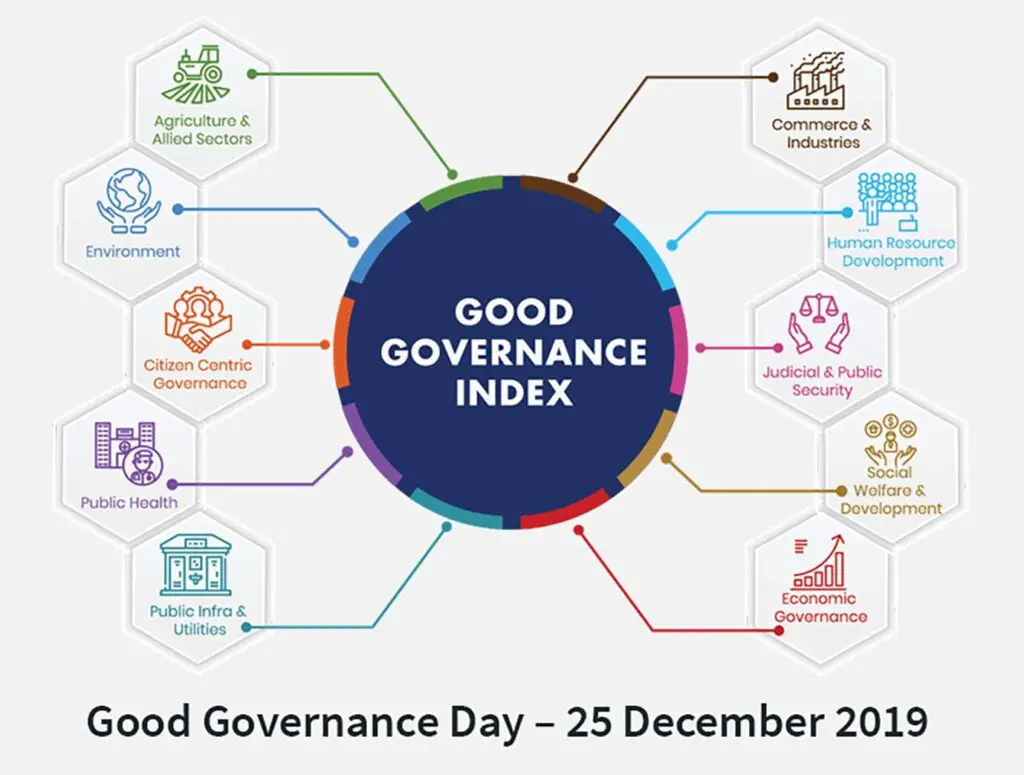Good governance plays a pivotal role in fostering sustainable development. It lays the foundation for a stable and foreseeable business environment, consequently driving economic expansion and employment opportunities. Simultaneously, it guarantees the prudent utilization of public assets, culminating in enhanced public services and infrastructure.

Good Governance
Key Aspects of Governance, Transparency, and Accountability
- E-Governance: E-governance encompasses a wide array of applications, models, successes, limitations, and untapped potential. It leverages technology to enhance government services, engage citizens, and improve efficiency.
- Citizens’ Charters: Citizens’ Charters are crucial tools for promoting transparency and accountability in governance. They outline the rights and expectations of citizens when interacting with government agencies.
- Transparency & Accountability: Transparency and accountability are cornerstones of ethical governance. They ensure that government actions are open to scrutiny, thereby minimizing corruption and fostering public trust.
- Institutional Measures: Various institutional mechanisms are employed to reinforce transparency and accountability in governance. These include regulatory bodies, ombudsmen, and audit agencies.
- Laws, Rules, Regulations, and Conscience: Ethical guidance in governance is drawn from laws, rules, and regulations, but it also relies on individual and collective conscience. Leaders and officials must navigate a complex ethical landscape.
- Accountability and Ethical Governance: Accountability is intertwined with ethical governance. Public officials are answerable for their actions and decisions, and ethical principles guide their behavior.
- Strengthening Ethical and Moral Values: Governance benefits from a strong foundation of ethical and moral values. Instilling these values in public servants and citizens alike is pivotal for fostering ethical governance.
- Corporate Governance: Corporate governance principles extend beyond the private sector. They also apply to government bodies and public institutions, emphasizing fairness, accountability, and transparency.
- Probity in Governance: Probity in governance rests on philosophical principles. It encompasses concepts of honesty, integrity, and adherence to ethical norms, ensuring that public officials act with the utmost integrity.
- Information Sharing and Transparency: Information sharing and transparency in government are bolstered by initiatives such as the Right to Information (RTI) Act, which grants citizens access to government records, fostering openness.
- Codes of Ethics and Conduct: Codes of ethics and conduct provide guidelines for public servants, delineating expected behavior and ethical standards.
- Work Culture and Quality of Service Delivery: An ethical work culture is vital for maintaining high-quality service delivery to citizens while upholding ethical principles.
- Utilization of Public Funds: Ensuring the responsible and ethical utilization of public funds is a fundamental aspect of governance, promoting efficiency and trust.
These facets collectively contribute to the establishment of a transparent, accountable, and ethical governance framework, essential for the effective functioning of public institutions.
Mains Questions PYQ
Q. Electronic cash transfer system is an ambitious project to minimise corruption, eliminate wastage and facilitate reforms. Comment. 2013
Q. Though Citizen’s charters have been formulated by many public service delivery organisations, there is no corresponding improvement in the level of citizens’ satisfaction and quality of services being provided. Analyse. 2013
Q. A national Lokpal, however strong it may be, cannot resolve the problems of immorality of public affairs.’ 2013
Q. In the light of Satyam Scandal (2009), discuss the changes brought in the corporate governance to ensure transparency and accountability. 2015
Q. If amendment bill to the Whistleblowers Protection Act 2011 tabled in the Parliament is passed, there maybe no one left to protect. Critically Evaluate. 2015
Q. “Effectiveness of the government system at various levels and people’s participation in the governance system are inter-dependent” Discuss their relationship in the context of India. 2016
Q. In the integrity index of Transparency International, India stands very low. Discuss briefly the legal, political, social and cultural factors that have caused the decline of public morality in India. 2016
Q. E-governance in not only about utilization of the power of new technology but also much about the critical importance of the ‘use value’ of information. Explain. (10) 2018
Q. The Citizen’s Charter is an ideal instrument of organisational transparency and accountability, but it has its own limitations. Identify the limitations and suggest measures for greater effectiveness of the Citizen’s Charters. (15) 2018
Q. Implementation of Information and Communication Technology (ICT) based projects/programmes usually suffers in terms of certain vital factors. Identify these factors and suggest measures for their effective implementation. (10 marks) 2019
Q. 4(b) There is a view that the official secrets act is an obstacle to the implementation of the Rights to Information act. Do you agree with the view? Discuss. 2019
Q. 2018 (b) “The Right to Information Act is not all about citizens’ empowerment alone, it essentially redefines the concept of accountability. Discuss. (150 words)
Q. 2017 (b) Corporate social responsibility makes companies more profitable and
sustainable. Analyse. (150 Words, 10)
Q. 2015 (b) Some recent developments such as introduction of RTI Act, media and
judicial activism, etc. are proving helpful in bringing about greater transparency and accountability in the functioning of the government. However, it is also being observed that at times the mechanisms are misused. Another negative effect is that the officers are now afraid to take prompt decisions.
Analyse the situation in detail and suggest how the dichotomy can be resolved. Suggest how these negative impacts can be minimised. (150 words) (10 Marks)
Q. Today we find that in-spite of various measures of prescribing codes of conduct, setting up vigilance cells/commissions, RTI, active media and strengthening of legal mechanism, corrupt practices are not coming under control. (10 Marks) (150 words) 2015
(a) Evaluate the effectiveness of these measures with justifications
(b) Suggest more effective strategies to tackle this menace
